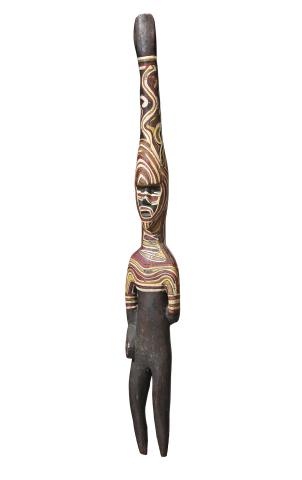UNTITLED (CEREMONIAL FIGURE), c.1968
ARTIST UNKNOWN (DOCKER RIVER REGION, NORTHERN TERRITORY)
synthetic polymer and enamel paint on carved hardwood
68.0 cm height
Collected by a surveyor working in the Docker River region, late 1968
Private collection, Melbourne
Sotheby's, Melbourne, 24 July 2007, lot 38
The Luczo Family collection, USA
Collected at Docker River (Kaltukatjara) in 1968, this small hardwood figure of a man wearing ceremonial headdress and richly painted in flowing colours over a black ground, stands at the cusp between sporadic sculptural art forms that often surfaced in many areas of indigenous Australia and the explosion of sculptural production that occurred with the establishment of formal Art Centres.
The upper third of the figure – the dominant tall headdress that tapers upwards from the head to extend into a laterally-flattened face, the shoulders, upper arms and torso – are all rendered with house paint or acrylic, applied in vibrant sinuous bands of solid colour, each separated from the next by a narrow margin of black. A triangular beard is indicated by three vertical stripes of white, while bands of yellow, red and white cross the face beneath the eyes and again, below the nose, a band of red and white curves around the left corner of the mouth. While appearing initially to be quite stolid, the stance is rather, upon reflection, full of tension. With the left hand clasping the elbow of the right from behind, the figures stares impassively forward evoking the anxious anticipation prior to the commencement of a ceremony – an undercurrent echoed in the frantic swirling colours.
Importantly, both the style and decoration of the piece here represent a shift from the style of Western Desert art of the period, thereby suggesting its origin elsewhere. Indeed, although rare forms of naturalistic sculpture did occur in the Western Desert prior to the establishment of Art Centres – for example, the Ngayunangalgu figure attributed to Pankalyirri, in the collection of the National Gallery of Australia, Canberra, and other human figures collected by anthropologist Susan Woenne at Docker River also in 1969 and 1970 1 – they are completely different in style to this particular work. There is evidence however, that individual artists in this region (as in many other areas of Australia) often responded to external influences and thus, discovered new ways to express their perceptions of traditional life and customs. For example, the sculpted stockmen figures created in 1969 by Max Brumby, another artist from the Docker River area, are believed to have been influenced by sculptural forms from the Top End which the artist had seen previously during his visit to Darwin.2 It should be also noted that during the early 20th century, sculptural forms of ceremonial or spiritual significance occurred as far west as Broome and south into the Pilbara, so the influences here may possibly derive from far wider sources.
Irrespective of its origins or the rationale for its creation, the figure nevertheless encapsulates superbly the tensions and anxieties that universally precede the commencement of indigenous ceremonial activities.
KIM AKERMAN
1. Berndt, R.M., The Australian Aboriginal Heritage, Ure Smith, Sydney, 1973, pl. 120, 123 – 124, p.160
2. Berndt, R.M., ‘Aboriginal Art of Western Australia’, Art and Australia, vol. 16, no 4, 1979, pp. 372 – 6

